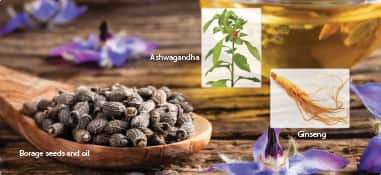Life Extension Magazine®
The drug metformin, prescribed to control blood sugar, has been shown to modulate many anti-aging pathways.1-5
In one animal study, metformin treatment led to a 14% extension of lifespan when treatment was begun early in life. Another rodent study with long-term metformin treatment also extended life.6,7
These data applied to humans would equate to prolonging an average human life from roughly 79 years to 90 years.
A metformin study in the C. elegans model of aging led to a remarkable 33% lifespan extension.8
A 2014 human study found that type II diabetics treated with metformin live longer than non-diabetics (who did not take metformin).9
Diabetics usually die sooner than non-diabetics, making this study showing diabetics taking metformin live longer than non-diabetics remarkable.
Seeking a metformin alternative, scientists used artificial intelligence (A.I.) technology to conduct a vast search for plant-based nutrients that mimic metformin’s effects.
They were able to identify three compounds that modulate many of the same pro-longevity pathways as metformin:1
- Withaferin A
- Ginsenoside Rg3
- Gamma-linolenic acid
These three compounds, when highly concentrated, function in overlapping and distinct ways to promote expression of longevity pathways.
Metformin Extends Lifespan

Metformin was first inspired by a nutrient found in a flowering plant known as French lilac.3
It lowers glucose levels via several mechanisms.
Much of metformin’s ability to improve insulin sensitivity is due to increasing a cellular enzyme called AMPK, considered a master regulator of cell metabolism.3
Increasing AMPK activity is an important target for anti-aging interventions.2
This ability of metformin to prevent age-related disease has been observed in humans.10-13
Based on its ability to extend life, a large, multi-site ($70 million) human trial is underway to ascertain if metformin can treat aging itself, just like chronic disease.14
How Metformin Fights Aging
Inspired by metformin’s remarkable longevity benefits, scientists set out to find alternatives in botanical compounds.1
Their first step was to identify precisely how metformin extends life. Several studies of metformin have shown that it affects cellular pathways tied to aging, including:2,4,15-21
- Stimulating AMPK, which helps balance mTOR and improves cellular metabolism and energy production,
- Decreasing levels of IGF-1, a hormone that has been found to be lowest in people who live exceptionally long lives, and
- Activating SIRT1, which regulates cellular health and is considered a longevity enzyme.
Through these effects and others, metformin can protect cells and tissues from the ravages of time that would otherwise lead to degeneration, dysfunction, and disease.
As a result of all these actions, metformin:2
- Improves metabolic health, maintaining insulin sensitivity, improving glucose control, and reducing production of potentially toxic byproducts of metabolism,
- Protects cellular structures from damage and degradation, including maintaining healthy proteins and DNA,
- Promotes cellular “housekeeping” (known as autophagy), which rids the body of old, damaged structures and rejuvenates it with healthy replacements, and
- Reduces harmful chronic inflammation and cellular senescence, which rob tissues of their function.
Using A.I. to Find Alternatives

The next step was to compare metformin’s actions with those of hundreds of plant-based compounds and see where the effects overlap.
In all, scientists identified 871 compounds that mimic metformin’s actions.
Sifting through this vast network of nutrients and their widespread interconnections would be practically impossible if it weren’t for the speed of artificial intelligence to explore these data.
Using deep-learning A.I., researchers found nutrients that regulate the same longevity pathways that metformin does. The artificial intelligence network was able to learn from these data and identify specific nutrients that most closely mimic the effects of metformin.1
A Three-Nutrient Combination
The results of the A.I. study revealed three nutrients that, taken together, would affect most of the same longevity pathways as metformin.
Some of the effects of these compounds overlap, bolstering the anti-aging impact compared to any one alone.
However, each one of the three compounds also confers unique and distinct benefits that sets it apart from the others.
Withaferin A
Withaferin A is an ingredient derived from ashwagandha, a plant that has been used for centuries in traditional Indian medicine to relieve stress, increase energy, and boost concentration.
Like metformin, withaferin A increases AMPK signaling and inhibits mTOR.22,23
What you need to know
Compounds Mimic Metformin’s Life-Extending Properties
- Metformin is a prescription drug used to treat patients with type II diabetes.
- In addition to aiding in the control of blood sugar, metformin has been found to have several anti-aging properties, extending lifespan and healthspan in animal models and humans.
- Inspired by metformin, scientists used advanced artificial intelligence technology to investigate and identify plant-based nutrients that mimic the properties of the drug.
- The scientists found three compounds that have both overlapping and distinct properties closely resembling those of metformin: withaferin A, ginsenoside Rg3, and gamma-linolenic acid.
- A combination of all three nutrients acts on similar health- and longevity-promoting pathways as metformin.
As a result, withaferin A has been shown to have beneficial effects on metabolism. In animal models, it blocked formation of new fat tissue, leading to weight loss, and improved insulin sensitivity and glucose control.24,25
Preclinical and animal models have demonstrated that withaferin A can also help maintain healthy protein synthesis inside cells, helping to shield them from some types of degeneration that occur with advancing age and disease.26-29
Ginsenoside Rg3
The ginsenosides are a group of compounds isolated from Panax ginseng (Asian ginseng), another plant widely used in traditional herbal medicine for a very wide range of indications.
Ginsenoside Rg3 activates AMPK, like metformin does.30-33 In addition, in cell and animal models it has shown potent activity to help promote the resolution of chronic inflammation.34,35
Practically all age-related diseases, from cardiovascular disease to cancer, have inflammation as a major contributing factor. Resolving chronic inflammation is one of the most promising potential ways to lower risk of disease and extend lifespan.
Like withaferin A, but through different mechanisms, ginsenoside Rg3 also prevented the degeneration of critical cellular structures like the mitochondria and cellular membranes in rodent models.36,37
Even more impressive, it has been shown to activate SIRT1 in a rat study.38 The sirtuins, and SIRT1 in particular, are signaling proteins that shield cells from age-related damage and dysfunction. Activation of SIRT1 has been shown in countless models to extend lifespan.39
Gamma-Linolenic Acid

A fatty acid found in various plants, gamma-linolenic acid (GLA) can be isolated from borage seed oil, among other sources.
Gamma-linolenic acid has been shown in clinical trials to effectively treat inflammatory conditions.40-42
In one, it significantly improved quality of life in patients with rheumatoid arthritis, reducing the swelling, stiffness, and pain in joints that is caused by chronic autoimmune inflammation.42
Summary

Metformin is a prescription medication which has been shown in animals and humans to improve long-evity via several well-established mechanisms.
Scientists have used deep-learning artificial intelligence technology to scour the natural world for nutrients that have similar life-extending properties as metformin.
This extensive search revealed three ingredients with combined effects closely resembling those of metformin: withaferin A, ginsenoside Rg3, and gamma-linolenic acid.
These three compounds, when provided in sufficient potencies, work in overlapping and distinct ways to promote the expression of life- and health-extending pathways in much the same way as metformin.
If you have any questions on the scientific content of this article, please call a Life Extension® Wellness Specialist at 1-866-864-3027.
References
- Aliper A, Jellen L, Cortese F, et al. Towards natural mimetics of metformin and rapamycin. Aging (Albany NY). 2017 Nov 15;9(11):2245-68.
- Barzilai N, Crandall JP, Kritchevsky SB, et al. Metformin as a Tool to Target Aging. Cell Metab. 2016 Jun 14;23(6):1060-5.
- Rena G, Hardie DG, Pearson ER. The mechanisms of action of metformin. Diabetologia. 2017 Sep;60(9):1577-85.
- Cuyas E, Verdura S, Llorach-Pares L, et al. Metformin Is a Direct SIRT1-Activating Compound: Computational Modeling and Experimental Validation. Front Endocrinol (Lausanne). 2018;9:657.
- Song YM, Lee YH, Kim JW, et al. Metformin alleviates hepatosteatosis by restoring SIRT1-mediated autophagy induction via an AMP-activated protein kinase-independent pathway. Autophagy. 2015;11(1):46-59.
- Anisimov VN, Berstein LM, Popovich IG, et al. If started early in life, metformin treatment increases life span and postpones tumors in female SHR mice. Aging (Albany NY). 2011Feb;3(2):148-57.
- Martin-Montalvo A, Mercken EM, Mitchell SJ, et al. Metformin improves healthspan and lifespan in mice. Nat Commun. 2013;4:2192.
- Cabreiro F, Au C, Leung KY, et al. Metformin retards aging in C. elegans by altering microbial folate and methionine metabolism. Cell. 2013 Mar 28;153(1):228-39.
- Bannister CA, Holden SE, Jenkins-Jones S, et al. Can people with type 2 diabetes live longer than those without? A comparison of mortality in people initiated with metformin or sulphonylurea monotherapy and matched, non-diabetic controls. Diabetes Obes Metab. 2014 Nov;16(11):1165-73.
- Goldberg R, Temprosa M, Otvos J, et al. Lifestyle and metformin treatment favorably influence lipoprotein subfraction distribution in the Diabetes Prevention Program. J Clin Endocrinol Metab. 2013 Oct;98(10):3989-98.
- Haffner S, Temprosa M, Crandall J, et al. Intensive lifestyle intervention or metformin on inflammation and coagulation in participants with impaired glucose tolerance. Diabetes. 2005 May;54(5):1566-72.
- Knowler WC, Barrett-Connor E, Fowler SE, et al. Reduction in the incidence of type 2 diabetes with lifestyle intervention or metformin. N Engl J Med. 2002 Feb 7;346(6):393-403.
- Goldberg RB, Aroda VR, Bluemke DA, et al. Effect of Long-Term Metformin and Lifestyle in the Diabetes Prevention Program and Its Outcome Study on Coronary Artery Calcium. Circulation. 2017 Jul 4;136(1):52-64.
- Available at: https://www.afar.org/research/TAME/. Accessed February 10, 2020.
- Caton PW, Nayuni NK, Kieswich J, et al. Metformin suppresses hepatic gluconeogenesis through induction of SIRT1 and GCN5. J Endocrinol. 2010 Apr;205(1):97-106.
- Luo Z, Zang M, Guo W. AMPK as a metabolic tumor suppressor: control of metabolism and cell growth. Future Oncol.2010 Mar;6(3):457-70.
- Vitale G, Brugts MP, Ogliari G, et al. Low circulating IGF-I bioactivity is associated with human longevity: findings in centenarians’ offspring. Aging (Albany NY). 2012 Sep;4(9):580-9.
- Bucci L, Ostan R, Cevenini E, et al. Centenarians’ offspring as a model of healthy aging: a reappraisal of the data on Italian subjects and a comprehensive overview. Aging (Albany NY). 2016 Mar;8(3):510-9.
- Milman S, Atzmon G, Huffman DM, et al. Low insulin-like growth factor-1 level predicts survival in humans with exceptional longevity. Aging Cell. 2014 Aug;13(4):769-71.
- Lu SP, Kato M, Lin SJ. Assimilation of endogenous nicotinamide riboside is essential for calorie restriction-mediated life span extension in Saccharomyces cerevisiae. J Biol Chem. 2009 Jun 19;284(25):17110-9.
- Morris KC, Lin HW, Thompson JW, et al. Pathways for ischemic cytoprotection: role of sirtuins in caloric restriction, resveratrol, and ischemic preconditioning. J Cereb Blood Flow Metab. 2011 Apr;31(4):1003-19.
- Guo R, Gan L, Lau WB, et al. Withaferin A Prevents Myocardial Ischemia/Reperfusion Injury by Upregulating AMP-Activated Protein Kinase-Dependent B-Cell Lymphoma2 Signaling. Circ J. 2019 Jul 25;83(8):1726-36.
- Liu X, Li Y, Ma Q, et al. Withaferin-A Inhibits Growth of Drug-Resistant Breast Carcinoma by Inducing Apoptosis and Autophagy, Endogenous Reactive Oxygen Species (ROS) Production, and Inhibition of Cell Migration and Nuclear Factor kappa B (Nf-kappaB)/Mammalian Target of Rapamycin (m-TOR) Signalling Pathway. Med Sci Monit. 2019 Sep 12;25:6855-63.
- Abu Bakar MH, Azmi MN, Shariff KA, et al. Withaferin A Protects Against High-Fat Diet-Induced Obesity Via Attenuation of Oxidative Stress, Inflammation, and Insulin Resistance. Appl Biochem Biotechnol. 2019 May;188(1):241-59.
- Khalilpourfarshbafi M, Devi Murugan D, Abdul Sattar MZ, et al. Withaferin A inhibits adipogenesis in 3T3-F442A cell line, improves insulin sensitivity and promotes weight loss in high fat diet-induced obese mice. PLoS One. 2019;14(6):e0218792.
- Chhipa AS, Borse SP, Baksi R, et al. Targeting receptors of advanced glycation end products (RAGE): Preventing diabetes induced cancer and diabetic complications. Pathol Res Pract. 2019 Nov;215(11):152643.
- Lee J, Liu J, Feng X, et al. Withaferin A is a leptin sensitizer with strong antidiabetic properties in mice. Nat Med. 2016 Sep;22(9):1023-32.
- Patel P, Julien JP, Kriz J. Early-stage treatment with Withaferin A reduces levels of misfolded superoxide dismutase 1 and extends lifespan in a mouse model of amyotrophic lateral sclerosis. Neurotherapeutics. 2015 Jan;12(1):217-33.
- Tiwari S, Atluri VSR, Yndart Arias A, et al. Withaferin A Suppresses Beta Amyloid in APP Expressing Cells: Studies for Tat and Cocaine Associated Neurological Dysfunctions. Front Aging Neurosci. 2018;10:291.
- Hwang JT, Lee MS, Kim HJ, et al. Antiobesity effect of ginsenoside Rg3 involves the AMPK and PPAR-gamma signal pathways. Phytother Res. 2009 Feb;23(2):262-6.
- Lee S, Lee MS, Kim CT, et al. Ginsenoside Rg3 reduces lipid accumulation with AMP-Activated Protein Kinase (AMPK) activation in HepG2 cells. Int J Mol Sci. 2012;13(5):5729-39.
- Park MW, Ha J, Chung SH. 20(S)-ginsenoside Rg3 enhances glucose-stimulated insulin secretion and activates AMPK. Biol Pharm Bull. 2008 Apr;31(4):748-51.
- Xing W, Yang L, Peng Y, et al. Ginsenoside Rg3 attenuates sepsis-induced injury and mitochondrial dysfunction in liver via AMPK-mediated autophagy flux. Biosci Rep. 2017 Aug 31;37(4).
- Kang S, Park SJ, Lee AY, et al. Ginsenoside Rg3 promotes inflammation resolution through M2 macrophage polarization. J Ginseng Res. 2018 Jan;42(1):68-74.
- Zhang LP, Jiang YC, Yu XF, et al. Ginsenoside Rg3 Improves Cardiac Function after Myocardial Ischemia/Reperfusion via Attenuating Apoptosis and Inflammation. Evid Based Complement Alternat Med. 2016;2016:6967853.
- Sun M, Huang C, Wang C, et al. Ginsenoside Rg3 improves cardiac mitochondrial population quality: mimetic exercise training. Biochem Biophys Res Commun.2013 Nov 8;441(1):169-74.
- Tian J, Fu F, Geng M, et al. Neuroprotective effect of 20(S)-ginsenoside Rg3 on cerebral ischemia in rats. Neurosci Lett. 2005 Feb 10;374(2):92-7.
- Yang QY, Lai XD, Ouyang J, et al. Effects of Ginsenoside Rg3 on fatigue resistance and SIRT1 in aged rats. Toxicology. 2018 Nov 1;409:144-51.
- Chang HC, Guarente L. SIRT1 and other sirtuins in metabolism. Trends Endocrinol Metab. 2014 Mar;25(3):138-45.
- Senapati S, Banerjee S, Gangopadhyay DN. Evening primrose oil is effective in atopic dermatitis: a randomized placebo-controlled trial. Indian J Dermatol Venereol Leprol. 2008 Sep-Oct;74(5):447-52.
- Thies F, Nebe-von-Caron G, Powell JR, et al. Dietary supplementation with gamma-linolenic acid or fish oil decreases T lymphocyte proliferation in healthy older humans. J Nutr. 2001 Jul;131(7):1918-27.
- Zurier RB, Rossetti RG, Jacobson EW, et al. gamma-Linolenic acid treatment of rheumatoid arthritis. A randomized, placebo-controlled trial. Arthritis Rheum. 1996 Nov;39(11):1808-17.

